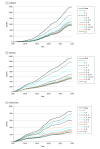Prioritizing Health Care Strategies to Reduce Childhood Mortality
- PMID: 36269354
- PMCID: PMC9587481
- DOI: 10.1001/jamanetworkopen.2022.37689
Prioritizing Health Care Strategies to Reduce Childhood Mortality
Abstract
Importance: Although child mortality trends have decreased worldwide, deaths among children younger than 5 years of age remain high and disproportionately circumscribed to sub-Saharan Africa and Southern Asia. Tailored and innovative approaches are needed to increase access, coverage, and quality of child health care services to reduce mortality, but an understanding of health system deficiencies that may have the greatest impact on mortality among children younger than 5 years is lacking.
Objective: To investigate which health care and public health improvements could have prevented the most stillbirths and deaths in children younger than 5 years using data from the Child Health and Mortality Prevention Surveillance (CHAMPS) network.
Design, setting, and participants: This cross-sectional study used longitudinal, population-based, and mortality surveillance data collected by CHAMPS to understand preventable causes of death. Overall, 3390 eligible deaths across all 7 CHAMPS sites (Bangladesh, Ethiopia, Kenya, Mali, Mozambique, Sierra Leone, and South Africa) between December 9, 2016, and December 31, 2021 (1190 stillbirths, 1340 neonatal deaths, 860 infant and child deaths), were included. Deaths were investigated using minimally invasive tissue sampling (MITS), a postmortem approach using biopsy needles for sampling key organs and fluids.
Main outcomes and measures: For each death, an expert multidisciplinary panel reviewed case data to determine the plausible pathway and causes of death. If the death was deemed preventable, the panel identified which of 10 predetermined health system gaps could have prevented the death. The health system improvements that could have prevented the most deaths were evaluated for each age group: stillbirths, neonatal deaths (aged <28 days), and infant and child deaths (aged 1 month to <5 years).
Results: Of 3390 deaths, 1505 (44.4%) were female and 1880 (55.5%) were male; sex was not recorded for 5 deaths. Of all deaths, 3045 (89.8%) occurred in a healthcare facility and 344 (11.9%) in the community. Overall, 2607 (76.9%) were deemed potentially preventable: 883 of 1190 stillbirths (74.2%), 1010 of 1340 neonatal deaths (75.4%), and 714 of 860 infant and child deaths (83.0%). Recommended measures to prevent deaths were improvements in antenatal and obstetric care (recommended for 588 of 1190 stillbirths [49.4%], 496 of 1340 neonatal deaths [37.0%]), clinical management and quality of care (stillbirths, 280 [23.5%]; neonates, 498 [37.2%]; infants and children, 393 of 860 [45.7%]), health-seeking behavior (infants and children, 237 [27.6%]), and health education (infants and children, 262 [30.5%]).
Conclusions and relevance: In this cross-sectional study, interventions prioritizing antenatal, intrapartum, and postnatal care could have prevented the most deaths among children younger than 5 years because 75% of deaths among children younger than 5 were stillbirths and neonatal deaths. Measures to reduce mortality in this population should prioritize improving existing systems, such as better access to antenatal care, implementation of standardized clinical protocols, and public education campaigns.
Conflict of interest statement
Figures



References
-
- Sharrow D, Hug L, You D, et al. ; UN Inter-agency Group for Child Mortality Estimation and its Technical Advisory Group . Global, regional, and national trends in under-5 mortality between 1990 and 2019 with scenario-based projections until 2030: a systematic analysis by the UN Inter-agency Group for Child Mortality Estimation. Lancet Glob Health. 2022;10(2):e195-e206. doi:10.1016/S2214-109X(21)00515-5 - DOI - PMC - PubMed
-
- UNICEF; World Health Organization; World Bank Group; United Nations . Levels & trends in child mortality. Accessed September 14, 2022. https://childmortality.org/wp-content/uploads/2021/12/UNICEF-2021-Child-...
-
- World Health Organization . Children: improving survival and well-being. September 8, 2020. Accessed October 4, 2021. https://www.who.int/news-room/fact-sheets/detail/children-reducing-morta...
-
- World Health Organization . Every newborn: an action plan to end preventable deaths. June 24, 2014. Accessed September 14, 2022. who.int/initiatives/every-newborn-action-plan

